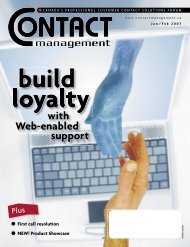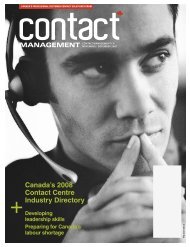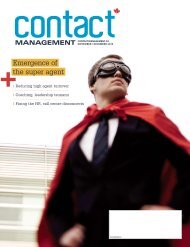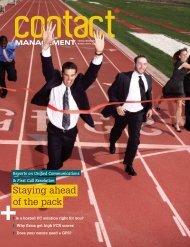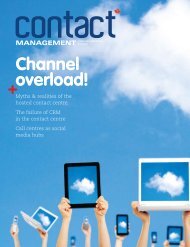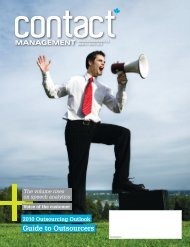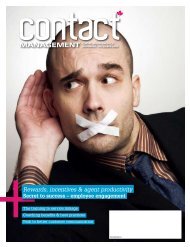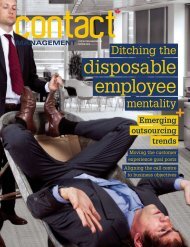2010 Contact Centre Industry Directory First Call Resolution–The ...
2010 Contact Centre Industry Directory First Call Resolution–The ...
2010 Contact Centre Industry Directory First Call Resolution–The ...
You also want an ePaper? Increase the reach of your titles
YUMPU automatically turns print PDFs into web optimized ePapers that Google loves.
Focus on FCR<br />
internal methods over inflate FCR<br />
performance and therefore, when<br />
your FCR performance is in the mideighties<br />
there is no sense of urgency<br />
to make improvements.<br />
Figure 65<br />
Leading and lagging indicators<br />
Each method for measuring FCR<br />
is useful in helping centers improve<br />
their FCR performance. However,<br />
the external method in which the<br />
customer determines if their call<br />
was resolved on the first call is what<br />
matters the most.<br />
Using multiple methods for<br />
measuring FCR is a best practice<br />
because each FCR measurement<br />
method can be used for different<br />
insights and accountability for<br />
improving FCR performance. For<br />
instance, having the CSR ask the<br />
customer if they resolved their call,<br />
at the end of the call, creates CSR<br />
accountability for resolving the<br />
customer’s call and will also reduce<br />
the likelihood of the customer having<br />
to call back about the same issue<br />
or problem. Using the voice menu<br />
or call-back customer information<br />
allows the center’s intelligent call<br />
routing technology to route calls<br />
to the best CSRs. Both these FCR<br />
measurement methods can also be<br />
used to calculate FCR performance in<br />
real-time.<br />
Post-call surveys can provide FCR<br />
and call resolution performance data<br />
for bonus and recognition purposes<br />
from the CSR to the VP level. Most<br />
employees find the customer survey<br />
results for determining FCR and<br />
call resolution performance to be<br />
the most credible and accurate<br />
measurement method. Also, post-call<br />
surveys provide information about<br />
whether the call was resolved from a<br />
customer’s perspective while internal<br />
methods measure frequency of FCR<br />
and two-plus calls, but cannot truly<br />
determine if the customer’s call was<br />
resolved. Internal methods can be<br />
very helpful for root cause analysis to<br />
determine what is causing two-plus<br />
calls and for developing solutions for<br />
improving FCR.<br />
<strong>Call</strong> resolution, FCR and Csat<br />
are leading indicators<br />
Figure 65 shows the relationship<br />
between leading and lagging<br />
indicators. In SQM s experience, call<br />
resolution, FCR and Csat are the<br />
leading indicators of a customer<br />
continuing to do business or<br />
recommending the organization<br />
to others based on their call center<br />
experience.<br />
The leading indicator concept is<br />
important to note since many call<br />
centers want to use ‘continue to do<br />
business’ and ‘recommend to others’<br />
as metrics to measure the center’s<br />
performance. For customers to<br />
continue to do business with and/<br />
or recommend the organization to<br />
others as a result of their call center<br />
experience, the center must achieve<br />
call resolution, FCR, and top box<br />
Csat performance. Based on SQM’s<br />
research, customers are satisfied<br />
when their call is resolved and they are<br />
even more satisfied when it is resolved<br />
on the first call. In most cases, if the<br />
customer is also treated well on the<br />
call by the CSR, this becomes a world<br />
class call experience for the customer.<br />
The bottom line is that ‘the continue<br />
to do business’ and ‘recommend to<br />
others’ metrics cascade from call<br />
resolution, FCR and Csat metrics.<br />
Another important point to<br />
mention is that the statistical<br />
correlation among the leading<br />
indicators are very high. However, the<br />
statistical correlation between the<br />
leading and the lagging indicators are<br />
only moderately correlated.<br />
CSRs ask customers if their call<br />
has been resolved<br />
Many SQM clients have their CSRs<br />
ask customers at the end of the<br />
call if they have resolved their call.<br />
They set a target of 85 percent or<br />
higher of customers that are asked<br />
the call resolution question. This<br />
practice slightly increases call length;<br />
however, the real benefits of this<br />
practice is it increases CSR awareness<br />
and accountability to resolve<br />
customer calls, reduces repeat calls<br />
and improves Csat.<br />
It is very important to mention<br />
that many CSRs do not like asking the<br />
call resolution question. The main<br />
reason is that if CSRs are not able to<br />
resolve the call, they do not want<br />
to ask the call resolution question.<br />
We have several clients who have<br />
discontinued the call resolution<br />
question practice because their CSRs<br />
did not like asking that question.<br />
When those clients discontinued this<br />
practice, in most cases, their FCR and<br />
Csat performance decreased. SQM<br />
believes it to be a best practice to ask<br />
the call resolution question at the<br />
end of the call as a way to improve<br />
FCR and Csat performance. Many<br />
call centers end of call practices<br />
have CSRs ask customers, ‘Is there<br />
anything else I can do for you?’ We<br />
consider this to be a poor practice<br />
because it assumes that the CSR has<br />
already resolved the customer’s call.<br />
At SQM, we consider the following<br />
to be best practices for using a call<br />
resolution statement at the end of a<br />
customer s call:<br />
• CSR summarizes key aspects of<br />
the call and next steps<br />
• CSR must say call resolution<br />
closing statement<br />
• Note: The goal should be 85<br />
percent of the time and business<br />
rules need to be developed as to<br />
when not to use the call resolution<br />
closing statement.<br />
• Every customer must be<br />
consistently asked the call<br />
resolution closing statement<br />
• Note: The following are not call<br />
resolution statements and should<br />
not be used. ‘Have I answered all your<br />
questions/concerns’ , or, ‘Are you<br />
satisfied with the resolution’ , or, ‘Is<br />
there anything else I can do for you?<br />
CSRs use the following call<br />
resolution closing statements:<br />
• ‘Have I resolved the reason for<br />
your call today?’ (90 percent of the<br />
time the CSR asks this version) or<br />
• ‘Have I given you an option to<br />
resolve your call today?’ (10<br />
percent of the time the CSR asks<br />
this version)<br />
• CSR captures a ‘yes’ or ‘no’<br />
response on a CRM system; for<br />
the ‘no’ response, the CSR can use<br />
a drop down menu on the CRM<br />
system to tag the reason for the<br />
call being unresolved<br />
• If customer says ‘no’ , the CSR<br />
can ask the customer, ‘Why do<br />
you think I have not resolved the<br />
reason for your call?’<br />
• Train CSRs on how to handle<br />
customer’s ‘no’ responses to the<br />
call resolution question<br />
• If the CSR cannot resolve the<br />
customer’s call, the CSR can transfer<br />
the call to an escalation CSR<br />
• QA team tracks CSR call resolution<br />
performance for identifying<br />
opportunities for FCR improvements<br />
Use customer survey FCR data<br />
and feedback to improve<br />
One of the best, if not the best,<br />
sources of data for improving<br />
customer service and cost is<br />
customer survey FCR data and<br />
feedback. Customer survey data and<br />
feedback provide great insights into<br />
the reasons why customers did not<br />
get their call resolved on the first call.<br />
Collecting FCR performance data by<br />
areas such as LOB, segment, call type,<br />
call center, manager, supervisor, CSR,<br />
skill set, customer value or outsourcer,<br />
via customer surveys will determine the<br />
areas that need to be improved. The<br />
more areas you can collect customer<br />
survey FCR data, the more helpful it is<br />
identifying where the opportunities are<br />
to improve your FCR performance.<br />
One of the best sources of FCR<br />
data you can collect to improve your<br />
FCR performance is by call type.<br />
When examining FCR performance<br />
by call type, identify main call types<br />
(e.g., billing) and corresponding sub<br />
call types (e.g., balance, due date,<br />
details, explanation, make payment<br />
or payment arrangements) as to why<br />
customers had to call more than once<br />
to resolve their call. It is a best practice<br />
u see <strong>First</strong> <strong>Call</strong>... page 18<br />
January / February <strong>2010</strong> contact management.ca 17



